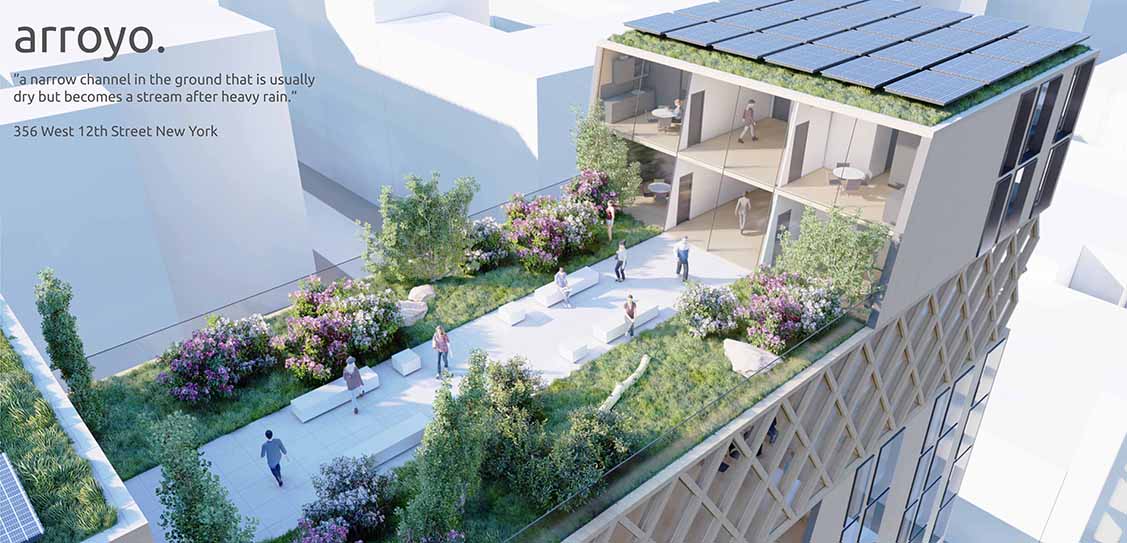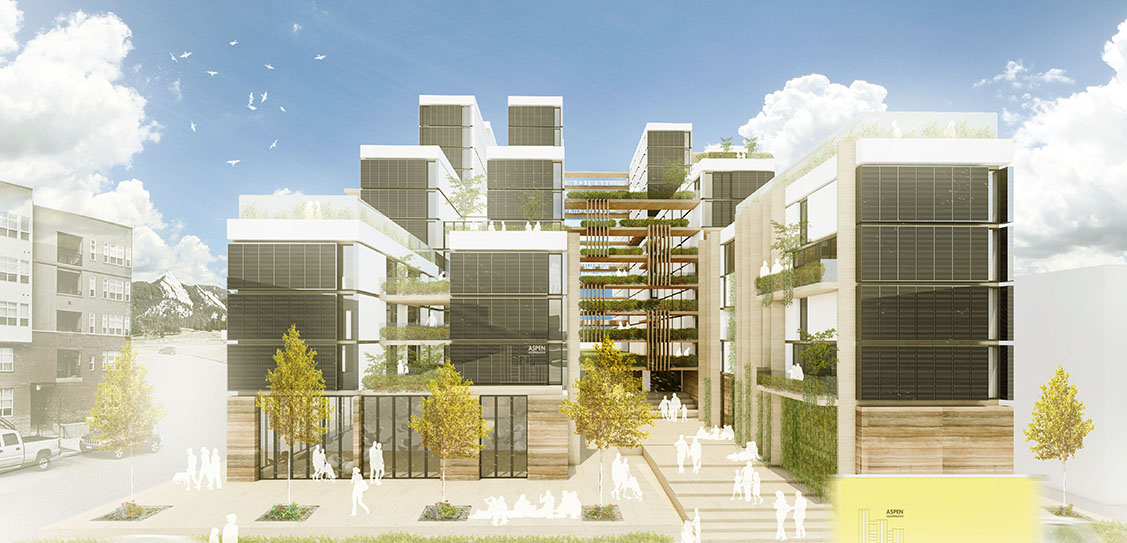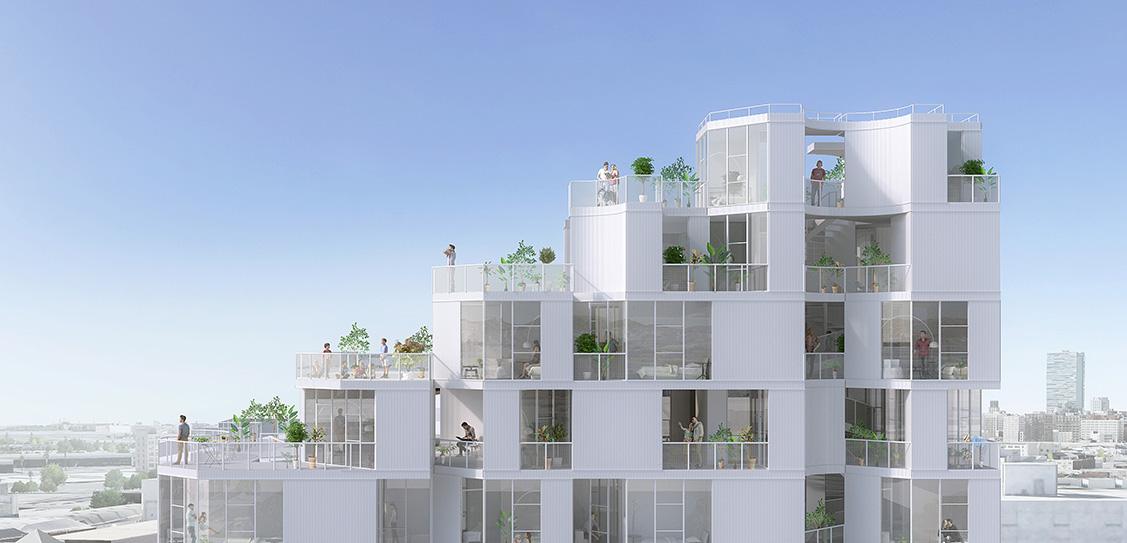A self sustaining community that embraces the diversity of New Yorkers has been named the winning entry of the annual 2020 Phil Freelon Design Competition.
Designed by Vangel Kukov and Hala El Khorazaty, the conceptual project transforms the site of a current industrial building in the West Village of Manhattan, one of New York City’s most expensive neighbourhoods, into a multigenerational, multicultural residential and civic hub that builds and strengthens community. Dubbed “Arroyo,” a Spanish word meaning a dry channel that becomes a stream after rain, the winning project symbolises the transformation of a lifeless space into one that flourishes with energy, activity, and human connectivity.
Infused with principles of social equity, the project also introduces a plan for subsidising residents’ monthly rent in exchange for community service. The outcome envisioned by Vangel and Hala is that the residents will strengthen their sense of community and thrive, physically, mentally, socially, and economically.
We know that a community is only as strong and as healthy as its individual members, so harnessing the principles of Living Design, inclusion, well being, sustainability, resilience, regeneration, was really important to our concept. The Phil Freelon Design Competition reminded us just how powerful design thinking can be when it comes to creatively tackling society’s most pressing issues.
This year’s challenge addressed the dire need for affordable housing, a growing humanitarian crisis in cities across the US. Research has shown that nearly half of all renters are cost burdened with prohibitively expensive rent, and that rising rents drive up rates of homelessness.
The concept of coliving is being reimagined in our growing technological age as a solution to address high costs of living. It also accommodates a desire for greater flexibility among temporary and permanent urban residents. To contribute to the value of this emerging industry, 68 design teams from around the firm accepted the challenge to create an affordable coliving concept that incorporates a shared economy, social networking, collaboration, and increased density. Economic inclusion, equity, well-being, and resilience were key design criteria.
Teams were free to choose from one of three real life sites, an industrial building in New York City’s West Village neighbourhood, a vacant asphalt lot in the historic Lodo area in Denver, and an industrial warehouse in downtown Los Angeles’s arts district. In addition to addressing unique site-based challenges, such as adaptively reusing existing infrastructure, the teams also had to consider ways to handle geographically specific environmental challenges, including sea level rise, flooding, and extreme drought. Teams had four days to conceptualise, visualise, and finalise their proposals. Then, a distinguished panel of jurors from outside Perkins and Will assessed each submission and selected the winners.
Arroyo took first place because of its practical yet innovative solution to providing affordable housing for a diverse range of people, jurors said. Despite its density, the design team was able to weave outdoor space throughout the entire building.
Instead of a second place, a third place winner this year, two projects tied for second; “Living Closer,” designed by Giancarlo Gastaldin and Gaia Cella, and “Our Backyard,” designed by Foad Faizi, Smith Marks, and Allen Pratt.
The Living Closer team chose to focus on all three sites, New York, Denver, and Los Angeles, by implementing a modular system that can easily respond to unique climate conditions and site specificity. Its prefabricated units can be disassembled, replaced, reused, and recycled over the course of the building’s lifespan to allow for expansion or downsizing, as needed. Jurors appreciated the team’s creative investigation into different unit types, as well as the diversity of ages, races, and ethnicities they included in their project’s renderings.
Similarly, the Our Backyard team focused on a modular system concept in New York. The designers created a flexible framework that allows living units to be arranged in multiple ways, catering to the lifestyle of young professionals. An open plan concept empowers tenants to become active participants in the community, while taking advantage of the site’s existing green space and its view. This strategy further maximised daylighting and created a better visual connection to the site and its surroundings.
The modules worked well together to eliminate corridors and maximise density.
The jury also selected three other projects to receive Merit Awards:
Aspen cooperative
Designed by Richard Schunemann, Vaia Vakouli, and Thomas Henderson Schwartz. Like an aspen grove, a group of individual trees but is actually a single organism stemming from the same root, Aspen Cooperative is rooted in interconnectivity. The team’s modernist scheme demonstrated well executed planning that integrates all sustainable elements in its cross laminated timber structure.
Pivot
Designed by Mahdiar Ghaffarian, Hannah Gibson, Alyssa Quiring and Rick Browner. The Pivot team designed a flexible, modular approach to housing built around choice and community culture. Its affordability allows individuals to transform their physical space and are incentivised to share space, resources, and amenities to contribute to affordability and social connection.
The sponge
Designed by Max Hu, Qian Yu, and Zhoufan Chen. The Sponge is an ambitious prefab model that maximises density. It offers its occupants unique housing styles and views throughout the building. The building’s voids and open space allows ample daylighting, creating spaces that foster a sense of community.



